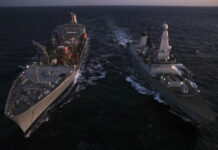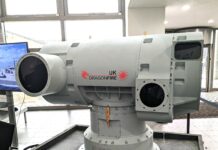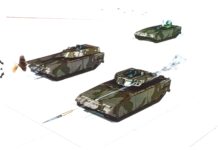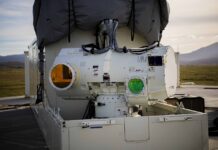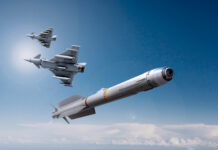In recent years, naval forces worldwide have dealt with the spread of challenging threats, from supersonic, high-diving or low-level and highly manoeuvrable anti-ship cruise missiles (ASCM) to swarms of asymmetric threats such as unmanned systems and fast attack craft, in addition to even more demanding hypersonic weapon systems in congested and contested littoral waters. This has required the industry and naval operators to move towards inner-layer defence systems (ILDS) with longer-range and networked capabilities alongside innovative solutions such as the laser-based systems.
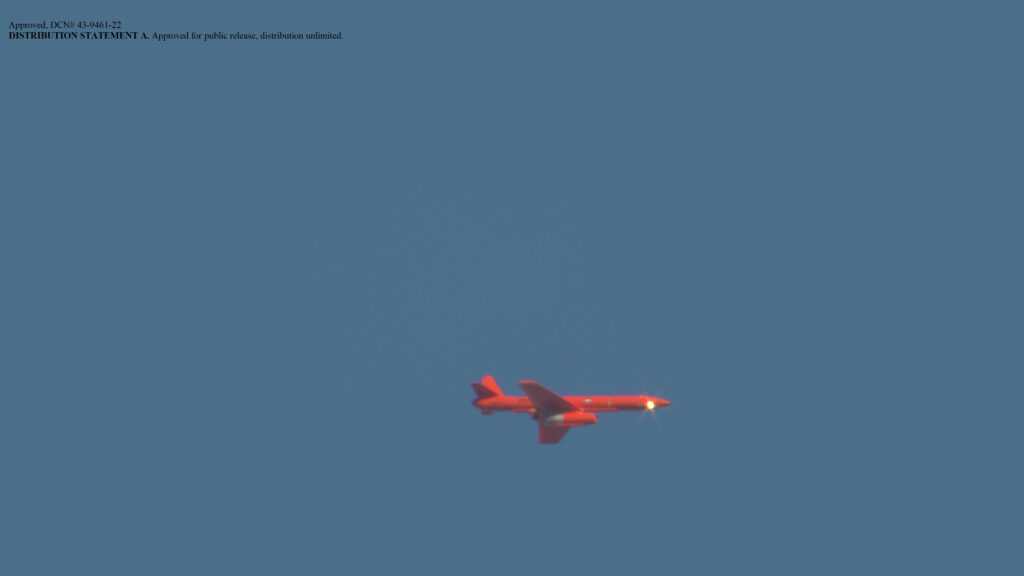
Guns
The Raytheon Mk 15 Phalanx with its 20 mm M61A1 six-barrel Gatling gun system continues to be the most widely-used self-contained all-weather, fully automatic CIWS (close-in weapon system). The aforementioned threats, which emerged during its service life, alongside new fire control and weapon technologies, have influenced the development and use of longer-range gun and missile systems.
In July 2021, the South Korean Defense Acquisition Program Administration (DAPA) selected and awarded LIG Nex1 the CIWS-II programme for the Republic of Korea (ROK) Navy. It aims to develop a next generation ‘last line of defence’ system for ships such as the FFX Batch III (Ulsan class) frigates, the future KDDX destroyers and the CVX aircraft carrier programmes. Scheduled to complete development in 2027, the CIWS-II is a stand-alone and over-deck system equipped with a 30 mm Gatling gun and a turret system with reduced radar cross-section (RCS) shape, incorporating a search and fire control system.
The latter includes an AESA (active electronically scanned antenna) search radar with four fixed antennas offering a 360° coverage and a fire control system (FCS) with an AESA tracking radar and an optronic sight with day camera and short-wave infrared (SWIR) imager. Thanks to an advanced fire control and automation, the CIWS-II is expected to be more capable, accurate and easy-to-maintain compared to the current Phalanx, though high procurement costs and 30 mm weapon effectiveness against modern anti-ship threats have raised questions.
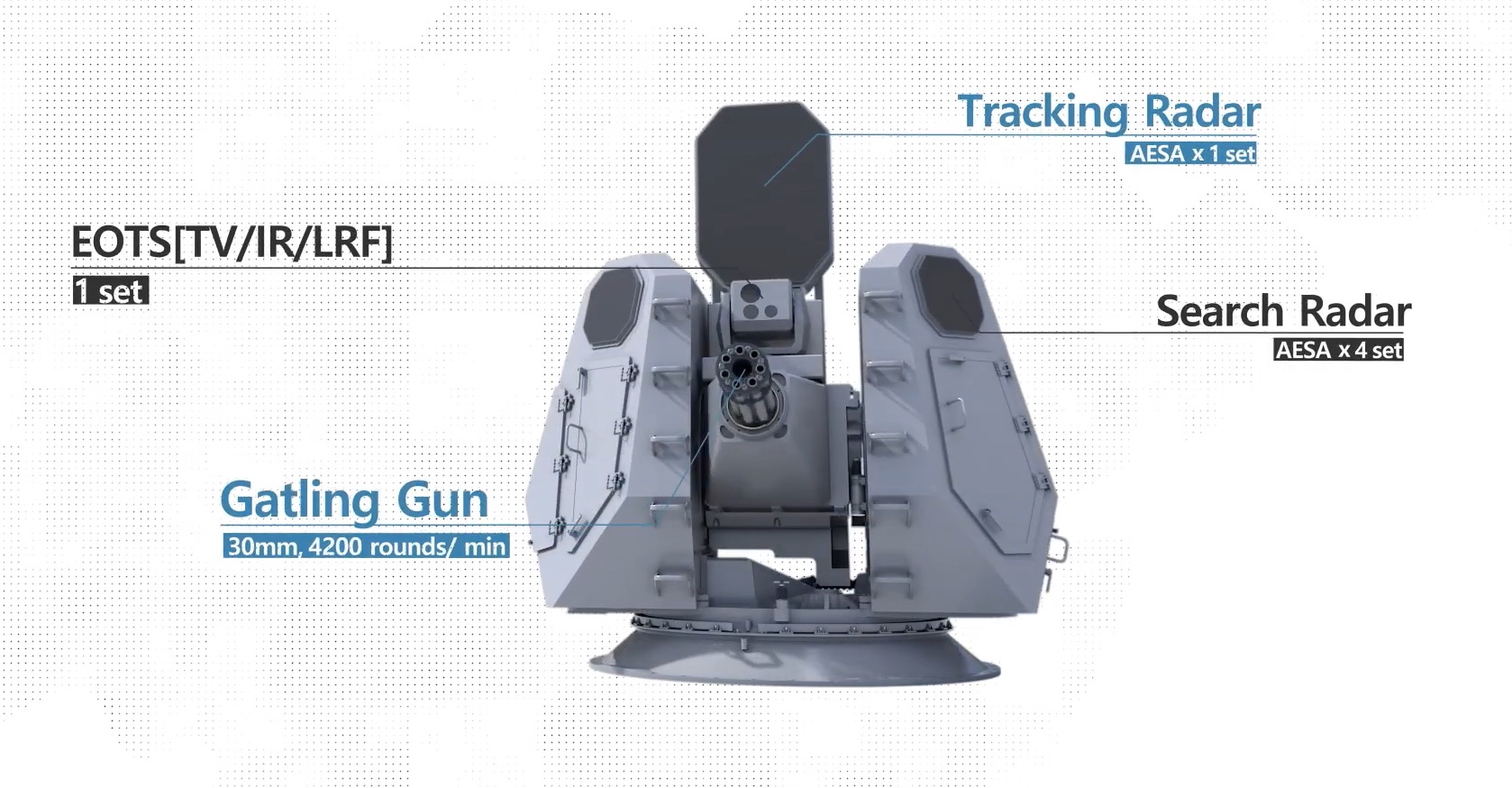
Turkish company MKEK has also developed an indigenous 20 mm CIWS known as YHSS (Yakin Hava Savunma Sistemi), unveiled for the first time during the IDEF 2021 exhibition. Developed to reduce the dependence on foreign systems and to increase export potential, the system architecture resembles the Phalanx CIWS, but it features a six-barrel 20 mm Gatling gun produced by MKEK itself. With a total weight without ammunition under 3,500 kg and a drum for 1,500 rounds (20 mm), the YHSS rate of fire is 3,000-4,000 rounds per minute. The gun system is currently equipped with an FCS with optronic sight including day and night sensors alongside a laser rangefinder, which receives target data from the ship’s Combat Management System (CMS). However, it is expected to receive a locally developed search radar in the future. In 4Q 2022, the YHSS was subjected to live-firing trials and qualification, after which it was to be delivered by year-end to the Turkish MoD.
Rheinmetall Air Defence continues to expand the club of customers using the Oerlikon Millennium naval gun system including on board the Danish Navy’s Iver Huitfeldt and Absalon class frigates. The system is in service with the Indonesian Navy on its new OPVs and is also mounted on board the Royal Saudi Navy’s Al Jubail class corvettes, the Venezuelan Navy and more recently the Colombian Navy on the new Damen/Cotecmar SIGMA 10514 frigates, making the latter service the first customer in Latin America.
The Oerlikon Millennium matches the 1,000 rounds/min fire rate of the Rheinmetall 35 mm 35/1,000 revolver gun system with the AHEAD (advanced hit efficiency and destruction) 35 × 228 mm air-burst ammunition, each round containing 152 tungsten sub-projectiles forming a lethal cone-shaped cloud ahead of the incoming target. On the basis of hit probability, the Millennium can defeat ASCM at ranges between 1-3 km and asymmetric threats such as multiple-axis swarms of fast attack craft up to 4.5 km. The Millennium doesn’t require through-deck penetration and is available in both standard and ISO-mount installation, the latter being a container shaped mechanical structure for rapid mounting and dismounting with an additional 252 round magazine.
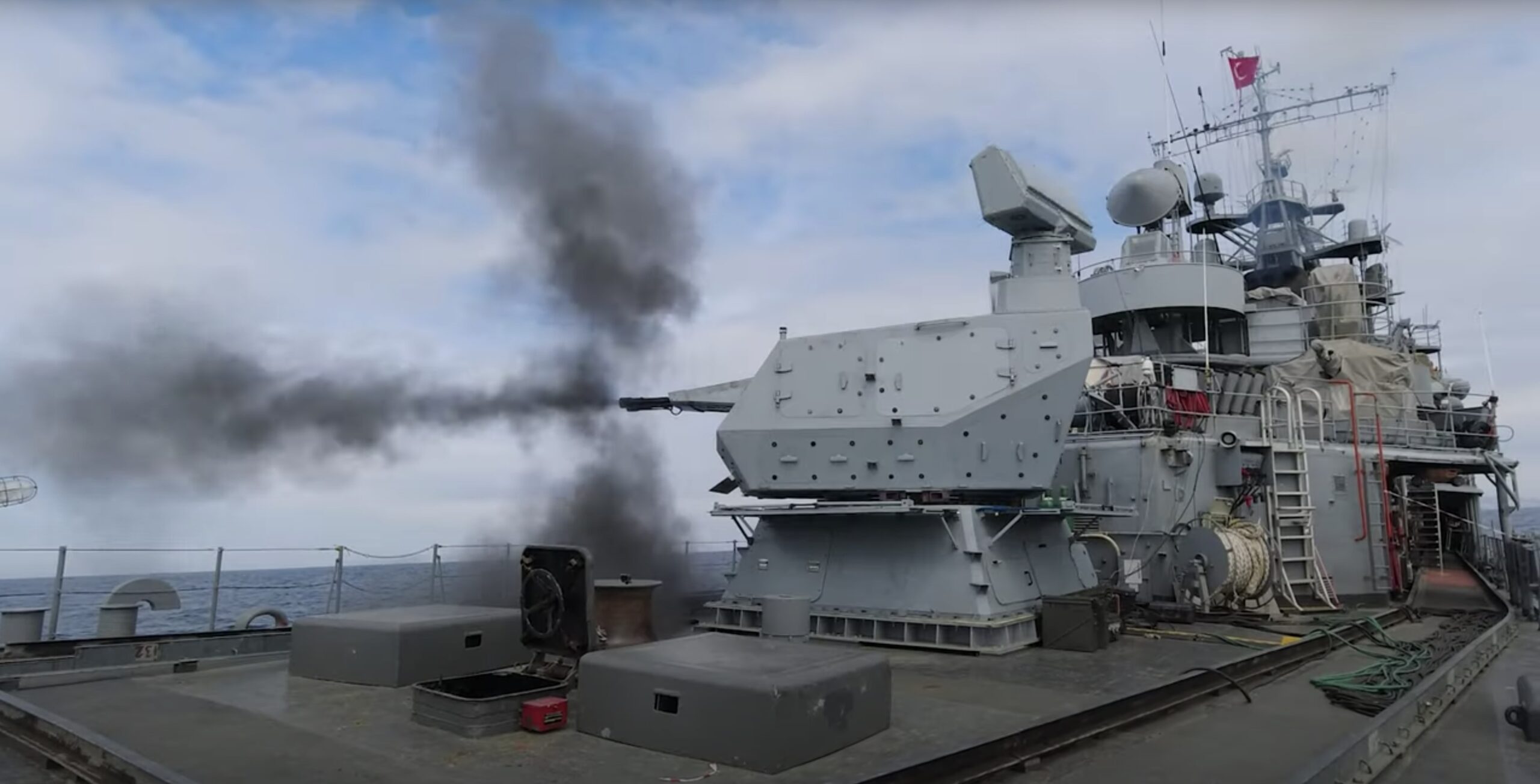
Turkish companies Aselsan and MKEK jointly developed the Gökdeniz 35 mm twin cannon naval ILDS which has found both international and domestic success. Derived from the Korkut tracked SP anti-aircraft land system, the Gökdeniz is characterised by a variant of the Oerlikon 35 mm twin cannon manufactured under licence by MKEK and an FCS including tracking radar and ETOS for engagements based on CMS-provided target data while full autonomous engagement will be assured by a 3D search radar addition.
Thanks to its 35 mm twin gun system with a 1,100 rounds/min rate of fire for each gun and airburst ammunition (ATOM) developed by Aselsan, the system yields ship defence at an effective range of 4 km. The automatic linkless ammunition feed mechanism allows loading of both airburst and high-explosive incendiary ammunition at the same time, switching between 35 × 228 mm NATO-standard ammunition types as needed during operations. In addition to anti-ship missiles, Gökdeniz is also effective against helicopters, fighters, UAVs and asymmetric naval surface threats, capable of being installed on OPVs and medium-size vessels, according to MKEK. In addition to service with the Turkish Naval Forces, which qualified the system in May 2022, Gökdeniz initially found international success with the Turkmenistan and Pakistan navies followed by the Philippines according to Aselsan.
Guided Munitions and Medium-Calibre Guns
With the most widespread and versatile medium-calibre model, represented by the 76/62 mm Super Rapid (SR) gun mount and the new non-deck penetrating variant, the ‘Sovraponte’ 76/62 mm gun mount, Leonardo and the Italian Navy have been frontrunners in developing guided ammunition and directors. They achieved this initially with the SRGM in the Strales configuration and later with the long-range guided/unguided Vulcano family of 127 mm, 155 mm, and 76 mm ammunition.
Centred on the high-speed (muzzle velocity of ~1,100 m/s) Driven Ammunition with Reduced Time of flight (DART) guided round with an effective range of over 8 km and equipped with a Ka-band antenna to provide semi-active guidance mounted on the gun, the SRGM Strales has attracted the interest of operators worldwide. Along with Colombia, the SRGM Strales is in service in the Middle East with Egypt and soon with the UAE, while in the Asia-Pacific region, India will join the userbase alongside Singapore which hasn’t released any information but has shown renderings of the new equipped MRCVs (multi-role combat vessels). Taiwan also requested funding in its FY 2023 budget to arm its fleet of combatant vessels with SRGM Strales.

This capability is at the heart of the new Sovraponte 76/62 mm gun system, a new light gun mount, with almost 40% weight reduction compared to the SRGM, and lower footprint, along with no deck penetration. Characterised by a low-observable design extended to the air-cooled low-profile barrel and the Strales guidance package, the Sovraponte has the same rate of fire, number of ready-to-fire rounds, and capability to fire DART and Vulcano rounds as the SRGM.
In late June 2023, the Dutch MoD, being responsible for the ASW frigate joint programme on behalf of Belgium and the Netherlands, awarded Damen and Thales the contract for the design, construction and delivery of four ASW frigates (two each for respectively the Netherlands and Belgium). Following this, in July 2023, the Dutch MoD awarded Leonardo the contract for the supply of the 76/62 Sovraponte gun mounts to equip these ships, making the two Navies the first known international launch customers for this mount.
Deliveries are planned from 2027, and the contract also include a spare gun, as well as options for additional three Sovraponte systems to equip the Karel Doorman and John de Witt amphibious ships, and the new supply ship Den Helder, to be commissioned in 2025. These are expected to be followed by additional systems alongside the Raytheon RAM Mk 31 system for the Dutch Goalkeeper replacement.
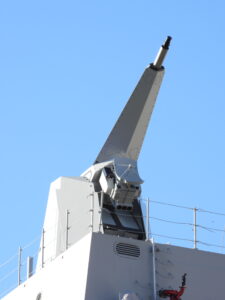
The US Navy is also evaluating advanced technologies for medium-calibre ammunition under the Defense Advanced Research Projects Agency’s (DARPA) Multi-Azimuth Defense Fast Intercept Round Engagement System (MAD-FIRES) demonstration programme. It advances fire control and medium-calibre projectile technologies, and guided hit-to-kill technology enabling the multiple, simultaneous target, kinetic engagement mission at greatly expanded raid sizes. MAD-FIRES was developed by Raytheon Missiles & Defense, along with together with its target illuminator and engagement management system.
The munition itself is a hit-to-kill 57 mm round, which is understood to use a semi-active radar guidance system along with rocket-assisted propulsion to extend range. According to the US FY2024 presidential budget request documentation, the last phase of the programme, is focused on demonstrating end-to-end system performance against surrogate supersonic targets, and is expected to conclude in FY 2023
Missiles
In October 2022, German Defence procurement agency (BAAINBw) awarded the RAM-System (RAMSYS) consortium a contract for supplying 600 rolling airframe missiles (RAM) Block 2B (RIM-116C), with deliveries to the German Navy starting in 2024. Developed under US/German co-operation by Raytheon and German RAMSYS consortium (MBDA Deutschland and Diehl Group’s companies), the RAM MK 31 guided missile weapon system is an all-weather missile-based ILDS with an integral dual-mode (passive RF/IR) guidance, which switches to passive RF seeker after launch for acquisition lock/mid-course guidance and passing to IR seeker head for terminal phase.
Fired by a 21-round MK 49 RAM GMLS launcher and Mk 15 Mod 32 SeaRAM system, the RAM munitions in both Block 1 and 2 versions are operational or under delivery with Egypt, Greece, Japan, South Korea, Turkey, UAE and more recently Qatar, Mexico and soon Saudi Arabia, in addition to the US and Germany. The Dutch MoD’s selection of the RAM system in tandem with Leonardo’s Single Deck gun to replace the Goalkeeper and the recent award of the Netherlands/Belgium contract for the new ASW frigates, the club of RAM customers will soon be enlarged.
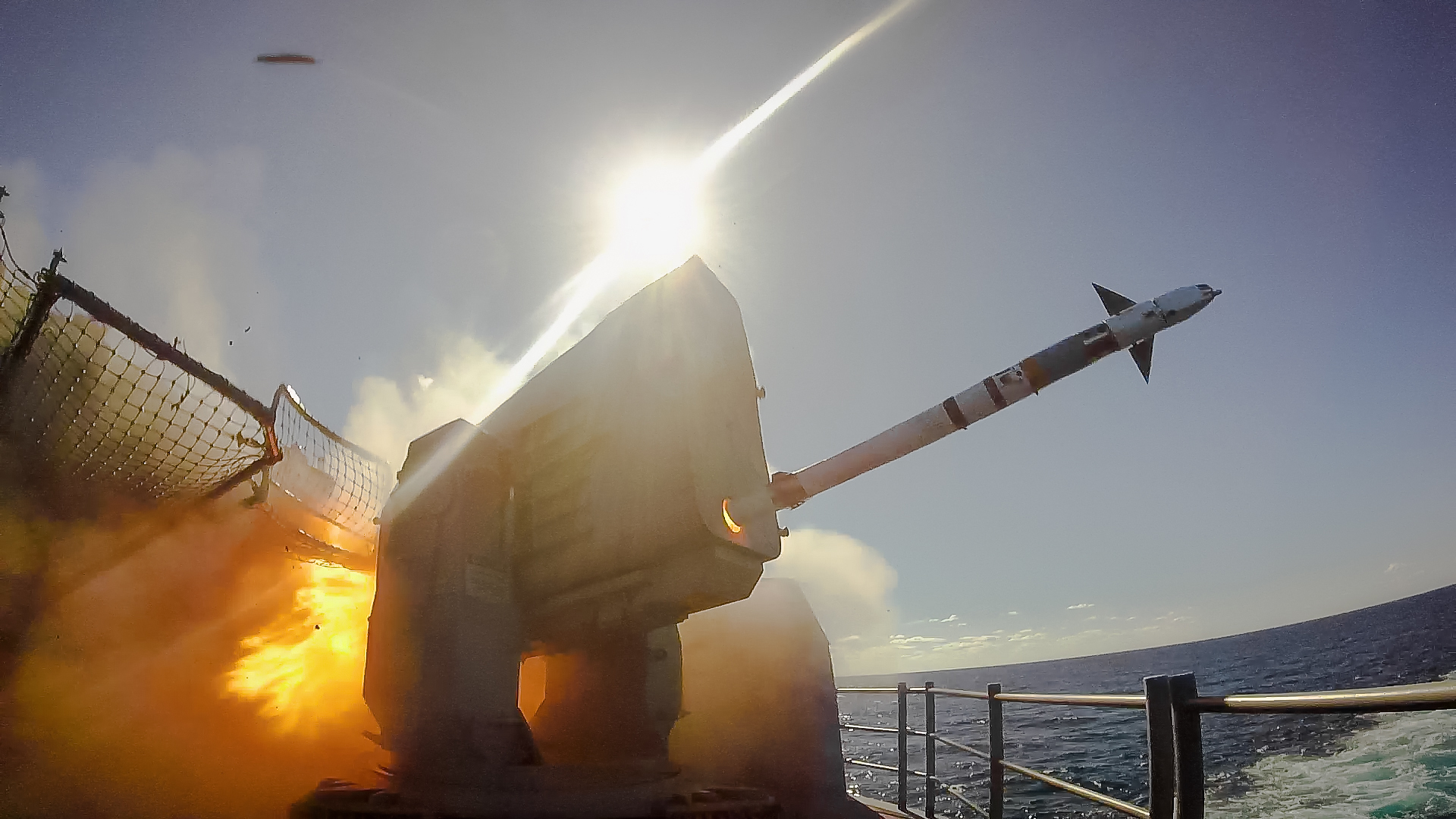
Credit US Navy
The Block 2 version adopts a larger and more powerful motor and independent four-canard control actuators to increase effective range by about 50% and deliver a three-fold improvement in manoeuvrability, a digital autopilot and an enhanced passive RF seeker to defeat the latest classes of ASCM, while maintaining the proven capabilities of the RAM Block 0/1/1A. Today, the production and qualification activities are focused on the Block 2B, which, in addition to improved performance against multi-threat raid attacks (Block 2A), adds an upgraded IR seeker and missile-to-missile Link (MML) capability to allow communications between in-flight missiles for target prioritisation/allocation against complex raid threats.
According to the US FY2024 PB request, in the upcoming four fiscal years, the US Navy will focus on integration efforts with the new Combat System baselines for aircraft carriers and amphibious platforms under the Ship Self-Defense System (SSDS) Baseline 12 – RAM integration activities. The service will also correct issues found during Block 2B development flight tests and will launch agile development efforts to deliver critical missile software-based capability packages to counter emerging threats, such as hypersonic weapons. Preliminary investigations to support RAM integration on AEGIS destroyers will also be conducted. In Europe, Thales will be focused on integrating RAM within the Above Water Warfare System (AWWS) fire control suite selected for both the German F126 and the joint Dutch/Belgian ASW frigate programmes.
In early June 2023, the Israel Missile Defense Organization (IMDO), in collaboration with the Israeli Navy and Rafael Advanced Defense Systems, announced the successful completion of a series of comprehensive tests for the Iron Dome naval version, called C-Dome. These tests, according to the press statement, mark a significant step towards achieving the final operational capability of the C-Dome system on the Israeli Navy’s Sa’ar 6 class corvettes. The live fire test series conducted by the involved ship’s crew included simulations of both existing and future threats that the Magen class ships may encounter in times of conflict, including rockets, cruise missiles, and UAVs.

Enabling hemispheric protection against saturation attacks, the C-Dome consists of one or more 10- round modular vertical launcher assemblies loaded with the same Tamir missiles as used in Iron Dome, possessing a maximum range of 10 km. C-Dome uses the host ship’s surveillance radar, without requiring a dedicated fire control radar, while the weapon command and control unit is integrated with the ship’s CMS. C-Dome is sufficiently compact to allow installation on smaller vessels such as the future Israeli Navy’s Reshef class corvettes. During IMDEX 2023 Rafael unveiled the C-Dome Mission Module solution for naval platforms.
This is effectively a platform-agnostic, modular variant of C-Dome intended to both allow retrofitting to older vessels, or mounting on ships which do not possess an organic self-defence capability, such as logistics support vessels. It includes a radar-equipped command and control (C2) shelter which carries out target detection and fire control, as well as a launcher module which can accommodate two 10-round vertical launchers, with both shelter and launcher fitting within the floor space taken up by a 20 ft ISO container.
During IDEF 2021, Turkish Roketsan unveiled a one-third size scale model of its Levent naval short-range missile defence system set to be embarked on light vessels for domestic and international markets and capable of countering different threats. The system can be armed with two different types of missiles, depending on the target and intercept range – the Sungur and the Levent missiles. The Sungur is a very short-range air defence (VSHORAD) missile with a minimum range of 500 m, a maximum range of 8 km and capable of attaining a maximum altitude of 4 km. In terms of guidance, it is equipped with an imaging infra-red (IIR) seeker, and operates in lock-on-before-launch (LOBL) mode only.
Powered by a dual-thrust solid propellant rocket motor, and is understood to be fitted with an HE-FRAG warhead with programmable fuze delay modes. Levant was in the concept design phase in mid-2021, with the missile envisioned to be is larger than the Sungur. Preliminary specifications state that the missile will weigh 70 kg, with a main body diameter of 128 mm and a maximum range of 11 km. Guidance is due to be based on a passive RF and IIR seeker. According to information released by Roketsan in May 2023, the first firing trials will be carried out at the end of 2023.

The expansion of the MBDA Mistral 3 userbase by ground forces is expected to foster the missile’s selection by new naval operators. The Mistral 3 is the latest variant of the missile family, and is equipped with new guidance and electronics, and improved range out to approximately 7 km. The missile is equipped with an IIR seeker developed by Safran which possesses sophisticated image processing capabilities, enabling the engagement of surface and aerial asymmetric threats with low-thermal signature such as small UAVs and turbojet-powered missiles in addition to resistance to countermeasures.
In addition to France, the Mistral family, including naval launchers in single or dual-launcher configurations, as well as SIMBAD, SADRAL and SIMBAD-RC systems, are in service with Indonesia, Norway, Saudi Arabia, the Philippines, and more recently Turkmenistan and Senegal.
The Advent of Naval Laser Weapons?
In February 2022, the US Navy completed the first test where an all-electric, high-energy laser (HEL) weapon was used to defeat a target representing a subsonic cruise missile in flight. Known as the Layered Laser Defense (LLD), the weapon was designed and built by Lockheed Martin to serve as a demonstrator.
The drone shoot-down by the LLD was part of an Office of Naval Research (ONR) demonstration at the US Army’s High Energy Laser Systems Test Facility at White Sands Missile Range in New Mexico in partnership with Lockheed Martin and the Office of the Under Secretary of Defense (Research and Engineering). Lockheed Martin has been working together with ONR to provide an embarked directed energy weapon (DEW) capability based on the LLD system to potentially be inserted into Phase two of the ‘Littoral Combat Ship (LCS) lethality and survivability’ upgrade programme, which will be defined in 2024.
As part of the US Navy Laser Family of Systems (NLFoS), the Navy is working on the High Energy Laser Counter ASCM Project (HELCAP) to develop and demonstrate various laser weapon technologies and methods of implementation required to defeat ASCMs in a crossing target engagement. A ‘detect to defeat’ demonstration of surrogate ASCMs, including static and dynamic ground targets and low-cost unmanned aerial targets, is planned to be conducted between 2Q FY 2023 and 4Q FY 2024.
Exploiting the testing and live firing campaigns already conducted on the land-based Iron Beam HEL, during IMDEX Asia 2023, Rafael announced the development of the Naval Iron Beam version, meant to be installed also on smaller platforms with the first planned application being the future Israeli Navy’s Reshef class corvettes. According to Rafael, the naval version will take four to five years to reach operational availability, and will be available in two configurations: integrated or modular standalone.
European industry has conducted a series of live tests on small drones, but in most cases the ultimate goal of these activities is expected to be the capability to engage and neutralise the threat coming from missiles as well as artillery shells and rockets in joint armed forces efforts.
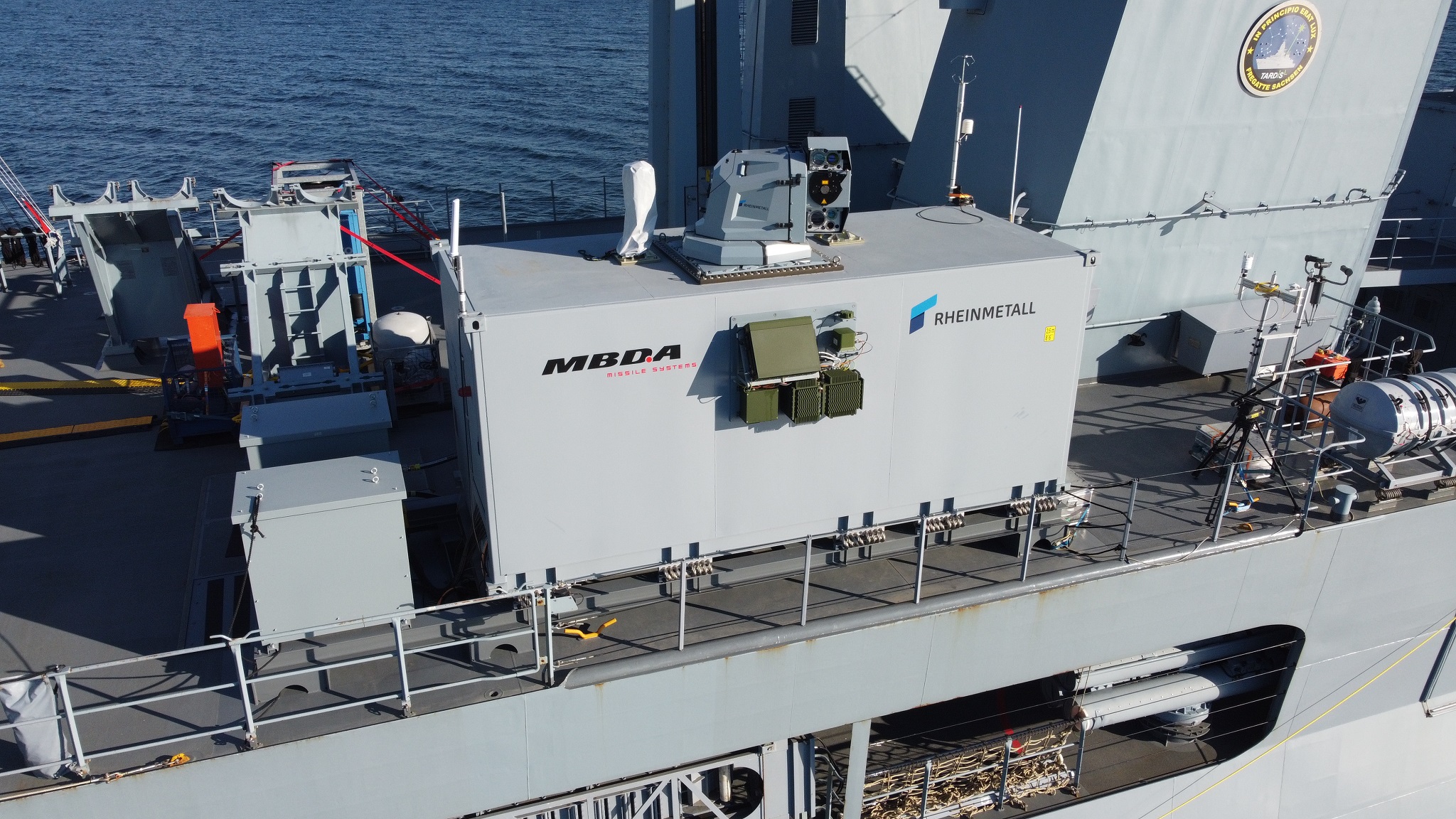
On 30 August 2022, the German frigate Sachsen successfully engaged drones at short and very short-range in the Baltic Sea test range. This was a German Armed Forces’ first shipboard laser weapon firing, which was developed together by MBDA Deutschland and Rheinmetall Waffe Munition GmbH.
Although future DEW will be deployed to defeat asymmetric threats, the system can also be designed for greater output, enabling it to destroy guided missiles and mortar rounds. Expected to run until mid-2023, these tests lay the foundation for the possible development of an operational laser weapon system for the German Navy, according to managing agency BAAINBw.
About two months later, MBDA and its partners in the UK MoD’s DragonFire consortium have successfully carried out the first static high-power laser firing of a domestic UK capability at the Defence Science and Technology Laboratory (Dstl) range in Porton Down. Using QinetiQ’s phase-combined laser demonstrator, generating power in the order of 50 kW, focused by Leonardo’s beam director and delivered using MBDA’s advanced image processing and command and control system, the trials showed that DragonFire could safely control and focus a high-power laser onto a precise point at long range.
In September 2021, the UK MoD awarded the contract to a national industrial team led by Thales UK, which includes BAE Systems, Chess Dynamics, Vision4CE and IPG, for the development and delivery of a direct laser energy weapon demonstrator for user experimentation on a Royal Navy Type 23 frigate starting in 2023.
In mid-June 2023, the French DGA agency, CILAS and the French Navy conducted a test campaign for the High Energy Laser for Multiple Applications-Power (HELMA-P) counter-UAV laser effector on board the French Navy’s Forbin air defence destroyer in the Mediterranean Sea. These tests open the door for further development of the prototype with a view to its long-term integration into French Navy ships.
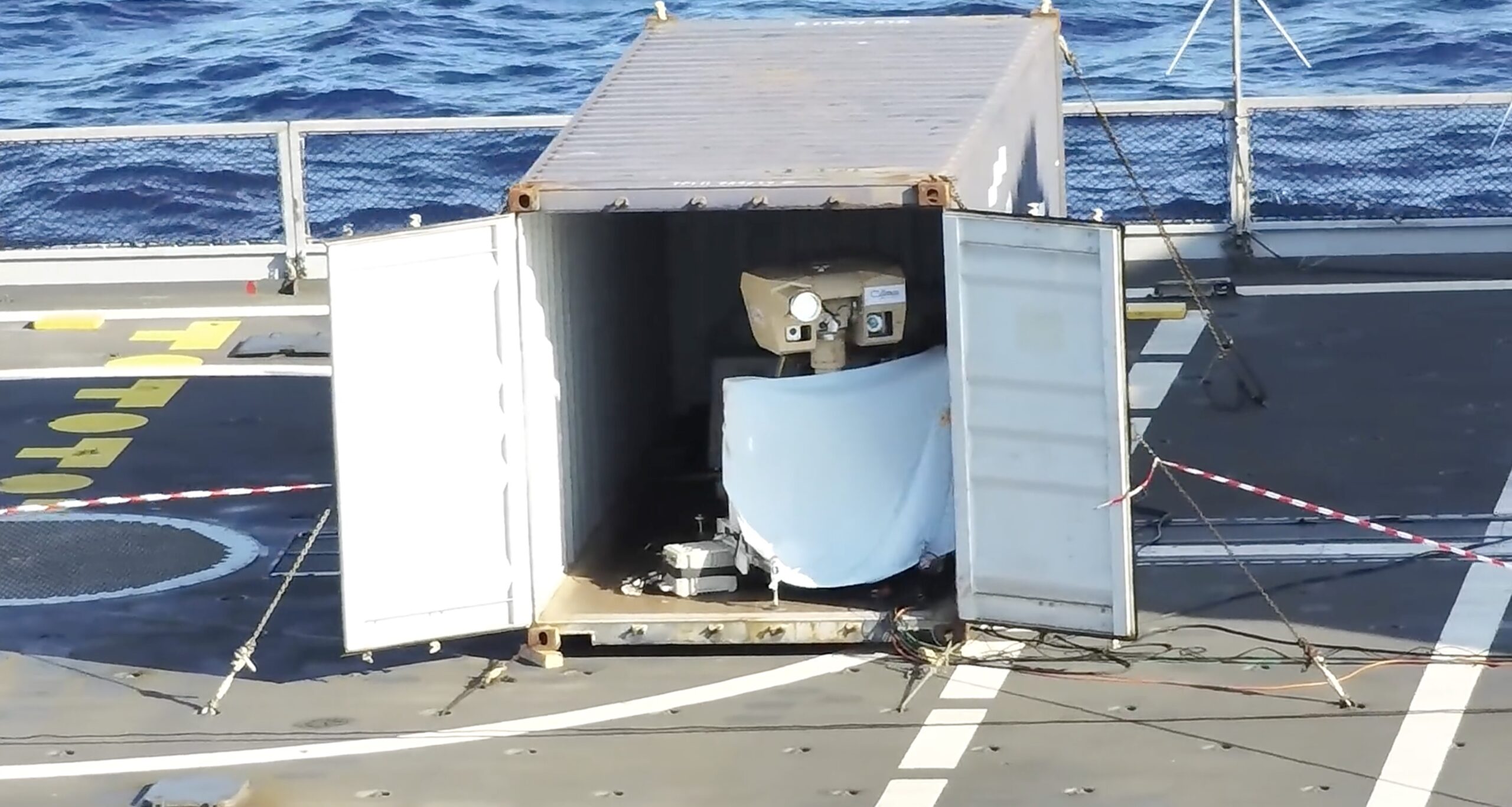
During the follow-on Paris Air Show 2023 edition, CILAS revealed the new system design which they had developed in cooperation with Ariane Group. According to CILAS, French industry is also working on the higher-power HELMA XP model to be available in 2027, and aims to be capable of defeating UAVs at longer ranges, but also combat the rocket, artillery, and mortar (RAM) threat.
Luca Peruzzi




